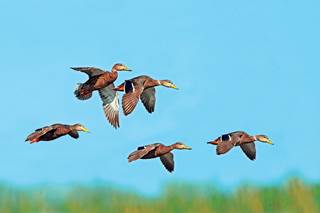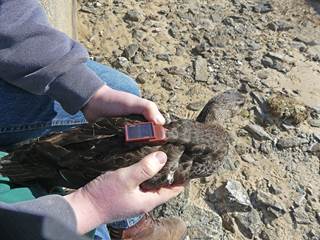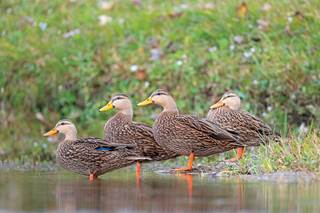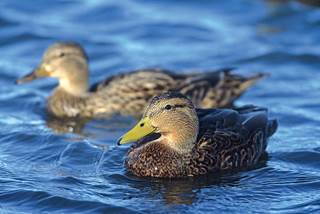The Greenhead Family Tree
Recent genetic research has revealed that the modern mallard and its close relatives share common Ice Age origins
Recent genetic research has revealed that the modern mallard and its close relatives share common Ice Age origins
By T. Edward Nickens
The birds came down the tree line, down the slough, and when they had circled enough times over the decoys and convinced themselves that all was well, they came down through the oak limbs and gum branches and into the Mississippi Delta timber hole. There is a moment when circling mallards put their worries to rest and commit to a piece of water. It's an inflection point you learn to recognize if you are lucky enough to see it often, and soon after you see it, the gun comes up and the shots go off and you will likely not recall the moment you decided to pull the trigger.
I picked up the greenhead, and he was a stud. Larger by a fifth than the others on the duck strap, this was a bird who no doubt had seen more than a migration or two. I could only imagine the great sweep of the continent that had passed beneath his wings. When I brought the bird back to my pals, I held it up high.
"Look at the size of this thing," I said. "Now, that is a boss greenhead."
I had yet to realize that I held a dinosaur.
Over the course of last year's hunting season, I had mallards on the brain. And not just greenheads. I had hoped to bring home all four of the mallard-related species known to the lower 48 states, a quest that would help me untangle the interwoven relationships between some of the best-loved-and least known-ducks in the country. The birds on my list included Anas platyrhynchos, the familiar and common mallard; the American black duck, A. rubripes; the mottled duck, A. fulvigula, which is native to Florida and the western Gulf Coast; and the relative newcomer to the species list, A. diazi, the Mexican duck.
I'll spoil the ending now: hunting from Maine to Florida and west to Arkansas, I took mallards, black ducks, and two mottled ducks, but not a Mexican duck. Simply attempting such a mallard family slam, however, and talking to researchers about the unfolding story of how these iconic birds came to inhabit such varied landscapes, was inspiring. And it's fueled a new desire to fulfill my quest. Mexican duck-I'm not through with you yet.

Photo © GaryKramer.net
Ducks maple-leafing through the trees might be the most salient image of mallard hunting in North America, and that visual of greenheads dropping down into decoys is an apt metaphor for how the mallard family pioneered and ultimately settled in various parts of North America. About 500,000 years ago, there existed only one mallard species in North America-an ancestral population that had arrived from Eurasia even earlier. Dr. Philip Lavretsky is an assistant professor of biological sciences at the University of Texas at El Paso and a leading researcher looking at the genetic map of waterfowl, especially the 14 worldwide species known as the "mallard complex." He says that this continent's proto-mallard was found across much of North America as a single species. But not for long. At least, not in a geological way of thinking.
Over the next few hundred thousand years, glaciers advanced southward across the continent, like dripping wax candles, then receded northward, repeating the process time and again. As they did, blankets of ice "literally pushed the mallard's ecology southward," says Lavretsky. His home state of Texas, for example, would have turned cool, wet, and marshy. Those original mallards were pushed south as well, and different populations were nudged into different corners of the continent. As the glaciers receded, many of those birds moved north with them, the ancestors of today's common A. platyrhynchos. Others, however, stayed in more isolated areas, in both the South and northeast, and adapted to take advantage of conditions in their new homes.
And that's where I went to find them.
The first leg of my quest took me to Maine, a stronghold for what many hunters consider the wariest waterfowl species of all-the American black duck. Serrated fir trees bristled on dark bluffs overlooking the Kennebec River, emblematic of the vast northern forests where most black ducks breed. I was hunting with a local decoy carver and boat maker, Frank Middleton, who sculled a sharply pointed gunning skiff through knotted marsh creeks where mallards and black ducks fed on the incoming tides.
Winding through the marsh, we jumped mallards and black ducks by the score. When a trio of black ducks vaulted to the sky in range, and a single drake fell to the reeds, it seemed I had closed a circle in some ways.
I held the bird in two hands, its heft suggesting the fat layer put on for migration. I've shot black ducks in North Carolina beaver swamps, where a single bird flying with mallards can steer the entire flock away from the decoys. I've shot them in the saltwater marshes of Currituck Sound, where a southerly population of the birds still breeds. But this was a black duck from its core range, nurtured and nourished in the northern latitudes where glaciation pushed a subset of ancestral mallards literally into a corner of the continent.
Isolated in what is now the northeastern United States and eastern Canada, birds that would become the black duck developed darker plumage over time, scientists think, to help them blend into the shadows of their heavily forested Boreal breeding grounds. Why black ducks also evolved to be so wary is anyone's guess-and a curse for every hunter who pursues them.
From a conservation perspective, black ducks have been under the microscope-literally and figuratively-for many years. Concerns that hybridization with mallards might significantly overtake the genetics of black duck populations were a major issue, although more recent genetic studies have alleviated some of those fears. While mallards and black ducks do interbreed, the overall population of black ducks is still large enough to absorb the mallard gene flow without significant change. That makes genetic swamping, at least on the population level, unlikely. "Hybridization still happens," explains Dr. John Coluccy, director of conservation planning in DU's Great Lakes/Atlantic Region, "but the concerns about genetic swamping of black ducks that were prevalent a few years ago aren't as intense. That's given us some breathing room to really drill down on the life history of black ducks and what their habitat needs are."
While black duck numbers have fallen dramatically-by more than 50 percent between the 1950s and 1980s-populations have since stabilized. New black duck research is aimed at teasing apart the details of how black ducks spend their time on core breeding, staging, and wintering areas and how that influences productivity. The Black Duck Joint Venture, University of Saskatchewan, and other partners recently kicked off a massive study of black duck ecology. All told, about 500 black duck hens will be captured and outfitted with the latest generation of telemetry devices-tiny solar-powered backpack GPS units built with cellular connectivity that automatically download data via nearby cellphone towers. The transmitters also incorporate accelerometer technology that allows researchers to identify and quantify time spent in various behaviors such as flying, resting, and feeding.
Meanwhile, studies of habitat use, feeding habits, and biomass of black duck foods across various wetland habitats on wintering areas are helping scientists answer questions they have long pondered. Are black ducks limited by a lack of quality wintering habitat that puts them at risk of higher mortality during the colder months? Are birds returning to the breeding grounds in less-than-optimal body condition? Finding answers to these questions is a perfect example of the way waterfowl science and conservation work hand in hand. "We'll be able to intersect all those findings to identify habitat deficits and surpluses," Coluccy says. "That will point us to places that need restoration and conservation."

New and ongoing research is helping biologists understand how black ducks use various habitats throughout the year, as well as where to target conservation efforts.
Photo © Steve Wright, Massachusetts Fisheries & Wildlife
While black ducks were adapting to cold climates and forested wetlands in the northeast, mallard relatives that remained in the southern latitudes were undergoing their own evolutionary journey. Deep in the South, birds that would evolve into the modern mottled duck were losing some of the mallard attributes that were no longer advantageous.
In that respect, mottled ducks are a keen expression of their environment. There are two distinct populations: one on the western Gulf Coast from Alabama into Texas and Mexico, and the other in peninsular Florida. (An introduced population of Gulf Coast mottled ducks has been established in coastal South Carolina.) Because mottled ducks were safely harbored in warmer climes, their need for migration receded. Without more brightly plumed competitors around, the birds lost their dramatic markings. Gone is the bright green head. The vibrant chestnut colors of the chest faded away. "It no longer made sense for a male to look pretty to attract a female," Lavretsky explains. "That just attracts more predation. It makes more sense for all the birds to look brown and somewhat cryptic."
But looking brown and drab doesn't mean being boring, not when the ancestral home to mottled ducks is deep subtropical Florida. Find them there, and hunting mottled ducks is like no other experience I've had in waterfowling.
A month after my black duck odyssey, I found myself in one of the stranger duck hunting environments I can recall. My buddy Chris Wittman poled a shallow-water flyfishing skiff through dense tunnels of mangroves. I batted away spiderwebs with my forearms as giant snook scattered in the light of our headlamp beams. We were knifing deep into the mangrove wilds of Florida's Caloosahatchee River, miles upstream from the famed J.N. "Ding" Darling National Wildlife Refuge at the river's mouth at Cape Coral.
To say we were committed is an understatement. Flowing tide had drained the creek. It was mere inches deep. We had to raise the mud motor and pull over the shallowest oyster bars. When we tucked into the far edge of a remote bay in the mangroves, we tossed out a half-dozen decoys and settled in. The tide was still running out. Mottled duck or no mottled duck, we were going nowhere for a while.
Older locals call mottled ducks "Glade ducks" in recognition of the birds' affinity for the Everglades, and while it's no heavy lift to lure them into stormwater retention ponds and other manmade environments, mottled ducks in their most natural surroundings aren't as easily fooled. The low tide had exposed a dark ring of mud around the bay, like a bathtub rim, and I feared our silhouettes looked just enough out of place to steer the ducks wide. It's a known habit for the birds: they might be a cinch to decoy early in the season, but that doesn't last.

Photo © GaryKramer.net
That wariness might well be rooted in the birds' evolutionary history, says Dr. Mike Brasher, DU's waterfowl scientist. "These species of the southern latitudes can almost behave like tropical duck species that will, in some cases, be paired up nearly year-round. That means many mottled ducks don't have much of a motive to associate with bigger flocks. They'll skirt your decoys and hole up in some little spot in the marsh where they won't be bothered. And early pairing allows them to take advantage of early breeding if the spring conditions are right."
It may be that Wittman's and my adaptation to local environmental conditions tipped the scales in our favor. Not long after we pushed back deeper into the mangroves, a flock of 10 mottled ducks winged toward us from across the pond. Most of the birds veered off the decoys, but a pair broke ranks, banked hard, and dropped nearly into shooting range before lifting off again.
We lost them in the dense mangroves behind us, but not for long.
"You hear that?" Wittman whispered, but I didn't hear a thing. And just then a duck came over my right shoulder. It drifted down to the back of the mangrove cove, and I watched it, appearing and disappearing behind the jungled screen, as it turned on a dime toward the decoys.
I tracked the bird through the mangroves and picked a hole in the green tangle to shoot through. It was almost too easy-the mottled duck's feet set, the slim wings pumping as it braked over the decoys. One shot at 25 yards dropped the bird. The daily limit for mottled ducks in Florida is a single specimen, and for a few seconds the moment seemed a bit anticlimactic. Until I raised my eyes off the water.
On the far side of the pond, I could barely make out the channel we had traveled in the dark. Getting out would prove sketchy-dragging the boat over oyster bars, poling through the mangrove jungle, sweating in waders. That single duck suddenly seemed just enough.
And there's more work in front of me. The last duck on my mallard family quest is the Mexican duck, the least studied waterfowl species in North America. It's easily found from west-central Mexico north to the US border, can be fairly common from central and southeastern Arizona to southern Texas, and will wander as far north as Colorado. And while I couldn't squeeze in a hunt for Mexican ducks last season, targeting its close kin, the mottled duck, lit a fire of aspiration. And given the recent status change of Mexican ducks, putting one in my sights is particularly timely.

Photo © GaryKramer.net
Mexican ducks were on the US Fish and Wildlife Service's first endangered species list, issued in 1967. But they were removed in 1978, when birds in the United States that had been thought to be Mexican ducks were declared to be a hybrid between the genetically pure Mexican duck south of the border and the mallard. More recent genetics work found that the US birds are, in fact, true Mexican ducks, and that the species is just as distinct a part of the mallard family tree as the black duck and the mottled duck and have been diverging from the mallard just as long. In 2020, the American Ornithological Society conferred full species status for A. diazi.
I suspect that I'm not the only waterfowler who now nurses a special hankering for a Mexican duck. In the hand, both sexes look like a very dark hen mallard, with the dark brown and khaki splotching a handsome contrast. Unlike the mottled duck, the greenish-blue speculum on a Mexican duck boasts white stripes both fore and aft, and the jaunty dark eye-stripe is more evident.
Like the mottled duck, Mexican ducks seem to adapt quickly to human disturbance when they're in more settled landscapes but are wary when pressured in the wild. As for how states will regulate Mexican duck harvest with the birds' full species status restored, the jury is still out. No final decisions have been made, said Kevin Kraai, waterfowl program leader for Texas Parks and Wildlife. One solution would be to simply drop the word "like" from current state regulations regarding "Mexican-like" ducks. "But no regulatory changes are planned regarding this species," Kraai explained. "Current federal regulations treat these birds like mallards, and due to similarities with hen mallards most states have a two-bird bag limit. Texas is a little more complicated due to contact zones between this species and mottled ducks; thus, we created a one-bird bag limit on 'dusky ducks,' defined as a mottled duck, Mexican-like duck, black duck, or their hybrids."
As for that ancestral, half-a-million-year-old original mallard, it still exists. A few years ago, I was stunned to read of Lavretsky's earlier reported findings that most Atlantic Flyway mallards carry a significant genetic payload from released "game farm" mallards bred from Eurasian ducks. But the research also showed that western and midcontinent mallards-like the one I held aloft in Mississippi-remain genetically identical to the historical mallard.
On the edge of that timber hole, we all marveled at how large that greenhead was, and how perfectly colored up. I didn't know then what I know now: that such a bird, in the hand or in the sky, is the closest I can get to that archetypal mallard of yore-the birds that outran the glaciers, put down roots in landscapes far from home, and ultimately evolved into the stunning array of mallard family ducks that now exist across the continent.
Like the black duck and the Mexican duck and mottled duck, each one has been shaped and molded by the landscapes of home. Each one is a gift from deep time.
Ducks Unlimited uses cookies to enhance your browsing experience, optimize site functionality, analyze traffic, and deliver personalized advertising through third parties. By continuing to use this site, you agree to our use of cookies. View Privacy Policy